World War Influencing Industrial Design
VerifiedAdded on 2023/06/15
|7
|1518
|435
AI Summary
The essay discusses the influence of world wars in the industrial design and mass production of the post-war period. It explores the changes in industrial design, the emergence of utility furniture, and the influence of new technologies. The essay also highlights the role of industrial designers in ushering in a new consumer society after the wars.
Contribute Materials
Your contribution can guide someone’s learning journey. Share your
documents today.
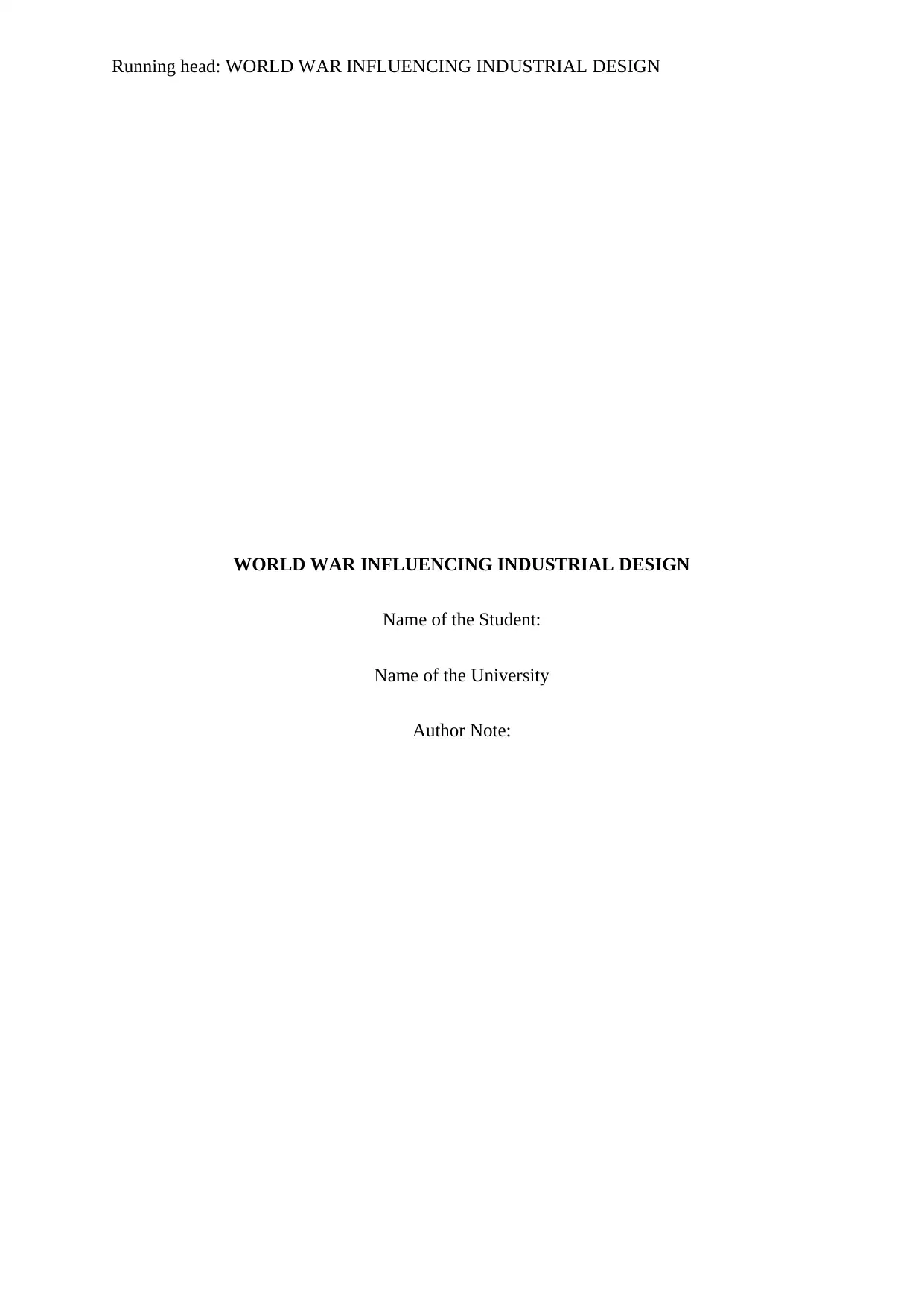
Running head: WORLD WAR INFLUENCING INDUSTRIAL DESIGN
WORLD WAR INFLUENCING INDUSTRIAL DESIGN
Name of the Student:
Name of the University
Author Note:
WORLD WAR INFLUENCING INDUSTRIAL DESIGN
Name of the Student:
Name of the University
Author Note:
Secure Best Marks with AI Grader
Need help grading? Try our AI Grader for instant feedback on your assignments.

1WORLD WAR INFLUENCING INDUSTRIAL DESIGN
The essay discusses the influence of world wars in the industrial design and mass
production of the post-war period. After both the world wars, the history of the world
changed drastically. People came across enormous changes that they never thought will take
place in their lives. World experienced enormous transformation not only in the society but
also in the deepest levels of morality and humanity.
As the pre-war era reveals life was simple yet productive but the wars proved that
ambition of power can destroy all the creations that the human society once created with
intense care. For the first time people witnessed that science not only has power to carry the
civilization towards a bright future, but utilised to kill people and grab territory (Gudem et al.,
2013). This section of human history has an enigmatic attraction towards which the modern
historians feel fascinated therefore try to analyse various aspects of the post war period. This
essay discusses the scientific and technological advancement that proved to be boon for the
human civilization.
The years following two World Wars were characterized by a new universal
generation of war troupers. They with their relatives were struggling for rebuilding their own
lives from a chaos. The persistent need for the inexpensive housing as well as furnishings
encouraged a boom in the industrial designing as well as production. A fresh optimism grew
up and promised a bright future and succeeded in their minds. This was the reason why the
furniture industry began to think from zero again. The main concern became to accommodate
more essential furniture in small places which grew the concept of utility furniture.
According to the researchers, the change in industrial designed was far reaching and
effective. They blended the cultural influences because the crisis was same in every nation.
Commercial jet transportation started working in 1957, comfort of travel in jet age
invigorated the rising fusion of the various cultural impacts. particularly amalgamated the
The essay discusses the influence of world wars in the industrial design and mass
production of the post-war period. After both the world wars, the history of the world
changed drastically. People came across enormous changes that they never thought will take
place in their lives. World experienced enormous transformation not only in the society but
also in the deepest levels of morality and humanity.
As the pre-war era reveals life was simple yet productive but the wars proved that
ambition of power can destroy all the creations that the human society once created with
intense care. For the first time people witnessed that science not only has power to carry the
civilization towards a bright future, but utilised to kill people and grab territory (Gudem et al.,
2013). This section of human history has an enigmatic attraction towards which the modern
historians feel fascinated therefore try to analyse various aspects of the post war period. This
essay discusses the scientific and technological advancement that proved to be boon for the
human civilization.
The years following two World Wars were characterized by a new universal
generation of war troupers. They with their relatives were struggling for rebuilding their own
lives from a chaos. The persistent need for the inexpensive housing as well as furnishings
encouraged a boom in the industrial designing as well as production. A fresh optimism grew
up and promised a bright future and succeeded in their minds. This was the reason why the
furniture industry began to think from zero again. The main concern became to accommodate
more essential furniture in small places which grew the concept of utility furniture.
According to the researchers, the change in industrial designed was far reaching and
effective. They blended the cultural influences because the crisis was same in every nation.
Commercial jet transportation started working in 1957, comfort of travel in jet age
invigorated the rising fusion of the various cultural impacts. particularly amalgamated the
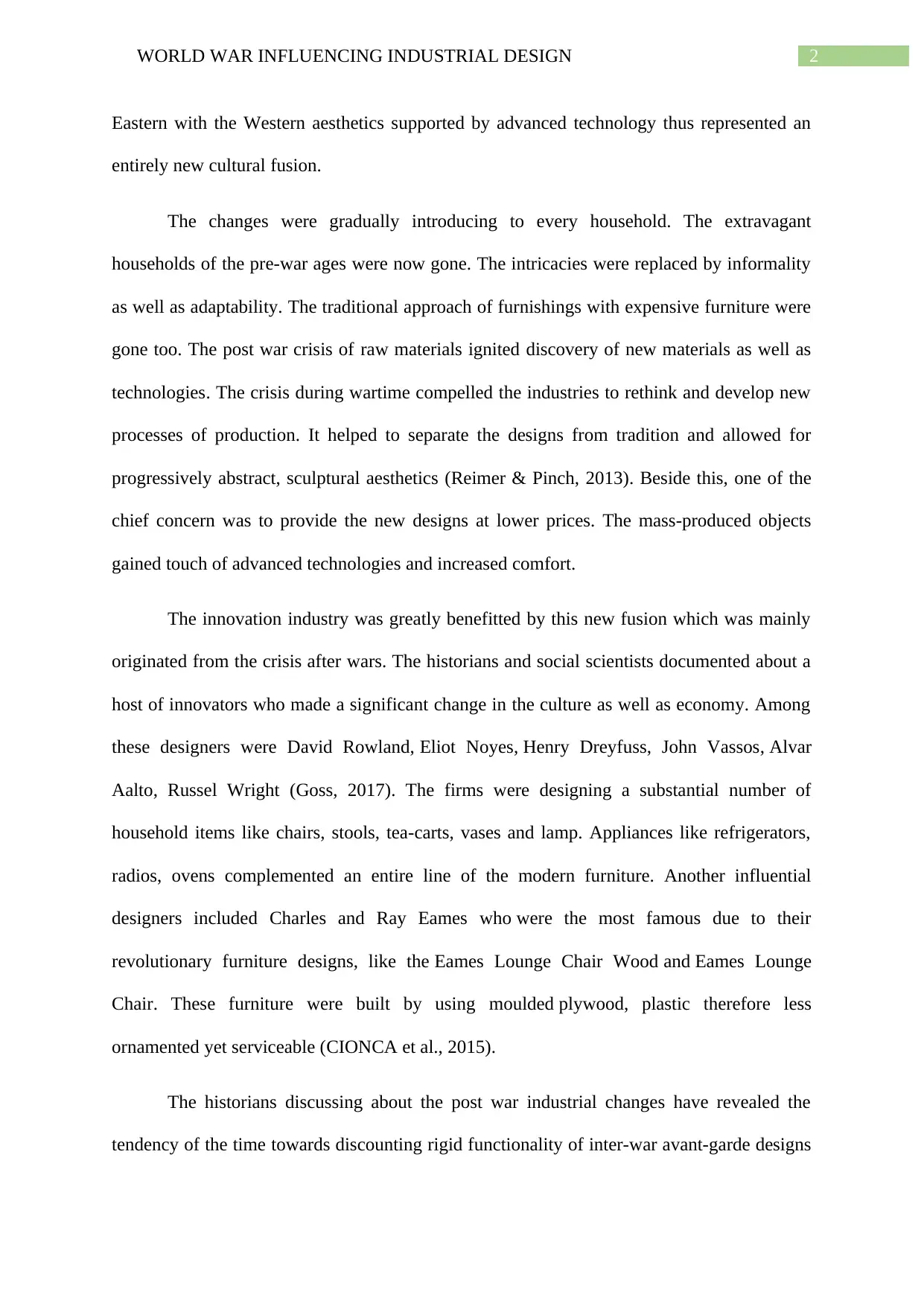
2WORLD WAR INFLUENCING INDUSTRIAL DESIGN
Eastern with the Western aesthetics supported by advanced technology thus represented an
entirely new cultural fusion.
The changes were gradually introducing to every household. The extravagant
households of the pre-war ages were now gone. The intricacies were replaced by informality
as well as adaptability. The traditional approach of furnishings with expensive furniture were
gone too. The post war crisis of raw materials ignited discovery of new materials as well as
technologies. The crisis during wartime compelled the industries to rethink and develop new
processes of production. It helped to separate the designs from tradition and allowed for
progressively abstract, sculptural aesthetics (Reimer & Pinch, 2013). Beside this, one of the
chief concern was to provide the new designs at lower prices. The mass-produced objects
gained touch of advanced technologies and increased comfort.
The innovation industry was greatly benefitted by this new fusion which was mainly
originated from the crisis after wars. The historians and social scientists documented about a
host of innovators who made a significant change in the culture as well as economy. Among
these designers were David Rowland, Eliot Noyes, Henry Dreyfuss, John Vassos, Alvar
Aalto, Russel Wright (Goss, 2017). The firms were designing a substantial number of
household items like chairs, stools, tea-carts, vases and lamp. Appliances like refrigerators,
radios, ovens complemented an entire line of the modern furniture. Another influential
designers included Charles and Ray Eames who were the most famous due to their
revolutionary furniture designs, like the Eames Lounge Chair Wood and Eames Lounge
Chair. These furniture were built by using moulded plywood, plastic therefore less
ornamented yet serviceable (CIONCA et al., 2015).
The historians discussing about the post war industrial changes have revealed the
tendency of the time towards discounting rigid functionality of inter-war avant-garde designs
Eastern with the Western aesthetics supported by advanced technology thus represented an
entirely new cultural fusion.
The changes were gradually introducing to every household. The extravagant
households of the pre-war ages were now gone. The intricacies were replaced by informality
as well as adaptability. The traditional approach of furnishings with expensive furniture were
gone too. The post war crisis of raw materials ignited discovery of new materials as well as
technologies. The crisis during wartime compelled the industries to rethink and develop new
processes of production. It helped to separate the designs from tradition and allowed for
progressively abstract, sculptural aesthetics (Reimer & Pinch, 2013). Beside this, one of the
chief concern was to provide the new designs at lower prices. The mass-produced objects
gained touch of advanced technologies and increased comfort.
The innovation industry was greatly benefitted by this new fusion which was mainly
originated from the crisis after wars. The historians and social scientists documented about a
host of innovators who made a significant change in the culture as well as economy. Among
these designers were David Rowland, Eliot Noyes, Henry Dreyfuss, John Vassos, Alvar
Aalto, Russel Wright (Goss, 2017). The firms were designing a substantial number of
household items like chairs, stools, tea-carts, vases and lamp. Appliances like refrigerators,
radios, ovens complemented an entire line of the modern furniture. Another influential
designers included Charles and Ray Eames who were the most famous due to their
revolutionary furniture designs, like the Eames Lounge Chair Wood and Eames Lounge
Chair. These furniture were built by using moulded plywood, plastic therefore less
ornamented yet serviceable (CIONCA et al., 2015).
The historians discussing about the post war industrial changes have revealed the
tendency of the time towards discounting rigid functionality of inter-war avant-garde designs
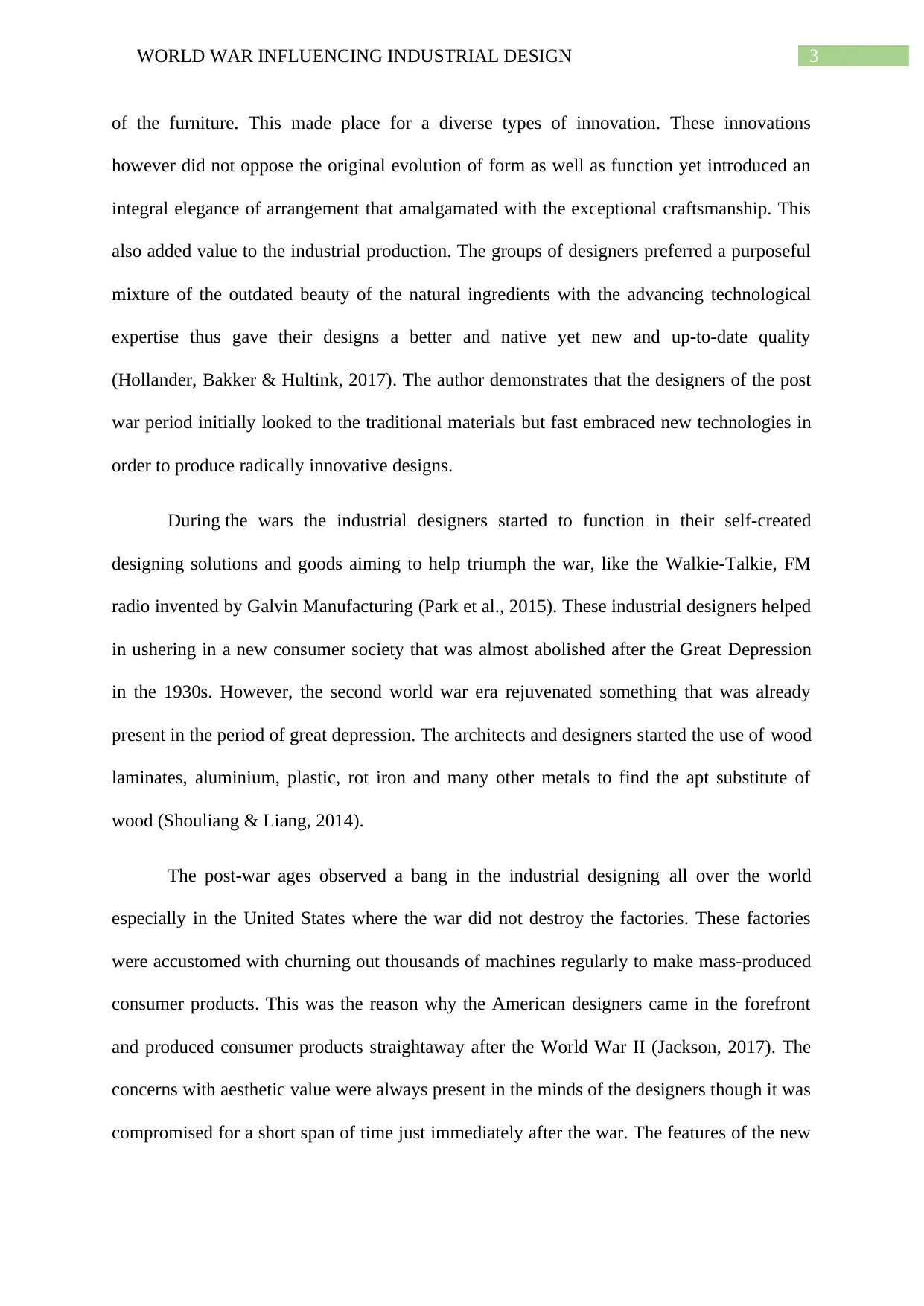
3WORLD WAR INFLUENCING INDUSTRIAL DESIGN
of the furniture. This made place for a diverse types of innovation. These innovations
however did not oppose the original evolution of form as well as function yet introduced an
integral elegance of arrangement that amalgamated with the exceptional craftsmanship. This
also added value to the industrial production. The groups of designers preferred a purposeful
mixture of the outdated beauty of the natural ingredients with the advancing technological
expertise thus gave their designs a better and native yet new and up-to-date quality
(Hollander, Bakker & Hultink, 2017). The author demonstrates that the designers of the post
war period initially looked to the traditional materials but fast embraced new technologies in
order to produce radically innovative designs.
During the wars the industrial designers started to function in their self-created
designing solutions and goods aiming to help triumph the war, like the Walkie-Talkie, FM
radio invented by Galvin Manufacturing (Park et al., 2015). These industrial designers helped
in ushering in a new consumer society that was almost abolished after the Great Depression
in the 1930s. However, the second world war era rejuvenated something that was already
present in the period of great depression. The architects and designers started the use of wood
laminates, aluminium, plastic, rot iron and many other metals to find the apt substitute of
wood (Shouliang & Liang, 2014).
The post-war ages observed a bang in the industrial designing all over the world
especially in the United States where the war did not destroy the factories. These factories
were accustomed with churning out thousands of machines regularly to make mass-produced
consumer products. This was the reason why the American designers came in the forefront
and produced consumer products straightaway after the World War II (Jackson, 2017). The
concerns with aesthetic value were always present in the minds of the designers though it was
compromised for a short span of time just immediately after the war. The features of the new
of the furniture. This made place for a diverse types of innovation. These innovations
however did not oppose the original evolution of form as well as function yet introduced an
integral elegance of arrangement that amalgamated with the exceptional craftsmanship. This
also added value to the industrial production. The groups of designers preferred a purposeful
mixture of the outdated beauty of the natural ingredients with the advancing technological
expertise thus gave their designs a better and native yet new and up-to-date quality
(Hollander, Bakker & Hultink, 2017). The author demonstrates that the designers of the post
war period initially looked to the traditional materials but fast embraced new technologies in
order to produce radically innovative designs.
During the wars the industrial designers started to function in their self-created
designing solutions and goods aiming to help triumph the war, like the Walkie-Talkie, FM
radio invented by Galvin Manufacturing (Park et al., 2015). These industrial designers helped
in ushering in a new consumer society that was almost abolished after the Great Depression
in the 1930s. However, the second world war era rejuvenated something that was already
present in the period of great depression. The architects and designers started the use of wood
laminates, aluminium, plastic, rot iron and many other metals to find the apt substitute of
wood (Shouliang & Liang, 2014).
The post-war ages observed a bang in the industrial designing all over the world
especially in the United States where the war did not destroy the factories. These factories
were accustomed with churning out thousands of machines regularly to make mass-produced
consumer products. This was the reason why the American designers came in the forefront
and produced consumer products straightaway after the World War II (Jackson, 2017). The
concerns with aesthetic value were always present in the minds of the designers though it was
compromised for a short span of time just immediately after the war. The features of the new
Secure Best Marks with AI Grader
Need help grading? Try our AI Grader for instant feedback on your assignments.
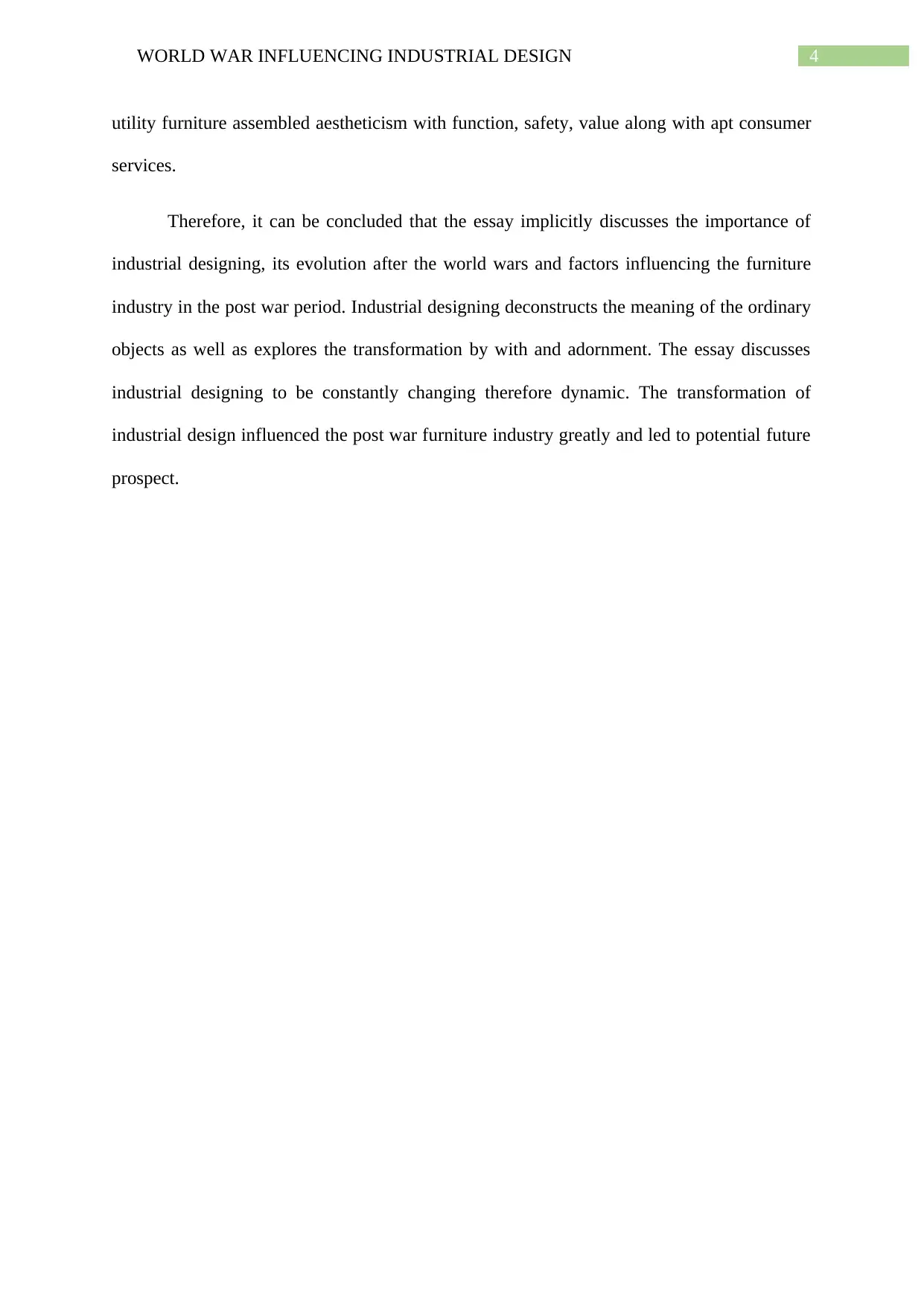
4WORLD WAR INFLUENCING INDUSTRIAL DESIGN
utility furniture assembled aestheticism with function, safety, value along with apt consumer
services.
Therefore, it can be concluded that the essay implicitly discusses the importance of
industrial designing, its evolution after the world wars and factors influencing the furniture
industry in the post war period. Industrial designing deconstructs the meaning of the ordinary
objects as well as explores the transformation by with and adornment. The essay discusses
industrial designing to be constantly changing therefore dynamic. The transformation of
industrial design influenced the post war furniture industry greatly and led to potential future
prospect.
utility furniture assembled aestheticism with function, safety, value along with apt consumer
services.
Therefore, it can be concluded that the essay implicitly discusses the importance of
industrial designing, its evolution after the world wars and factors influencing the furniture
industry in the post war period. Industrial designing deconstructs the meaning of the ordinary
objects as well as explores the transformation by with and adornment. The essay discusses
industrial designing to be constantly changing therefore dynamic. The transformation of
industrial design influenced the post war furniture industry greatly and led to potential future
prospect.
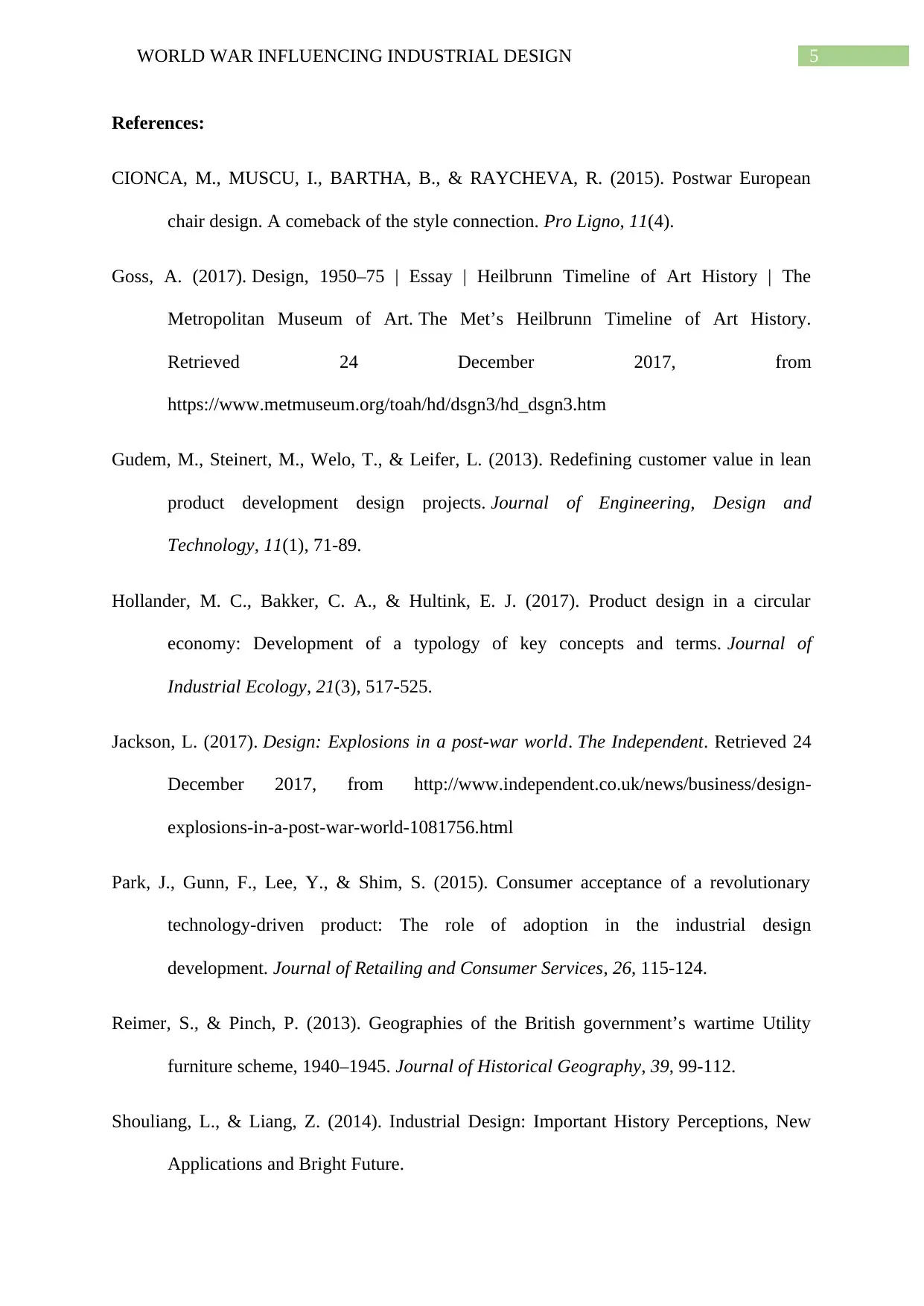
5WORLD WAR INFLUENCING INDUSTRIAL DESIGN
References:
CIONCA, M., MUSCU, I., BARTHA, B., & RAYCHEVA, R. (2015). Postwar European
chair design. A comeback of the style connection. Pro Ligno, 11(4).
Goss, A. (2017). Design, 1950–75 | Essay | Heilbrunn Timeline of Art History | The
Metropolitan Museum of Art. The Met’s Heilbrunn Timeline of Art History.
Retrieved 24 December 2017, from
https://www.metmuseum.org/toah/hd/dsgn3/hd_dsgn3.htm
Gudem, M., Steinert, M., Welo, T., & Leifer, L. (2013). Redefining customer value in lean
product development design projects. Journal of Engineering, Design and
Technology, 11(1), 71-89.
Hollander, M. C., Bakker, C. A., & Hultink, E. J. (2017). Product design in a circular
economy: Development of a typology of key concepts and terms. Journal of
Industrial Ecology, 21(3), 517-525.
Jackson, L. (2017). Design: Explosions in a post-war world. The Independent. Retrieved 24
December 2017, from http://www.independent.co.uk/news/business/design-
explosions-in-a-post-war-world-1081756.html
Park, J., Gunn, F., Lee, Y., & Shim, S. (2015). Consumer acceptance of a revolutionary
technology-driven product: The role of adoption in the industrial design
development. Journal of Retailing and Consumer Services, 26, 115-124.
Reimer, S., & Pinch, P. (2013). Geographies of the British government’s wartime Utility
furniture scheme, 1940–1945. Journal of Historical Geography, 39, 99-112.
Shouliang, L., & Liang, Z. (2014). Industrial Design: Important History Perceptions, New
Applications and Bright Future.
References:
CIONCA, M., MUSCU, I., BARTHA, B., & RAYCHEVA, R. (2015). Postwar European
chair design. A comeback of the style connection. Pro Ligno, 11(4).
Goss, A. (2017). Design, 1950–75 | Essay | Heilbrunn Timeline of Art History | The
Metropolitan Museum of Art. The Met’s Heilbrunn Timeline of Art History.
Retrieved 24 December 2017, from
https://www.metmuseum.org/toah/hd/dsgn3/hd_dsgn3.htm
Gudem, M., Steinert, M., Welo, T., & Leifer, L. (2013). Redefining customer value in lean
product development design projects. Journal of Engineering, Design and
Technology, 11(1), 71-89.
Hollander, M. C., Bakker, C. A., & Hultink, E. J. (2017). Product design in a circular
economy: Development of a typology of key concepts and terms. Journal of
Industrial Ecology, 21(3), 517-525.
Jackson, L. (2017). Design: Explosions in a post-war world. The Independent. Retrieved 24
December 2017, from http://www.independent.co.uk/news/business/design-
explosions-in-a-post-war-world-1081756.html
Park, J., Gunn, F., Lee, Y., & Shim, S. (2015). Consumer acceptance of a revolutionary
technology-driven product: The role of adoption in the industrial design
development. Journal of Retailing and Consumer Services, 26, 115-124.
Reimer, S., & Pinch, P. (2013). Geographies of the British government’s wartime Utility
furniture scheme, 1940–1945. Journal of Historical Geography, 39, 99-112.
Shouliang, L., & Liang, Z. (2014). Industrial Design: Important History Perceptions, New
Applications and Bright Future.
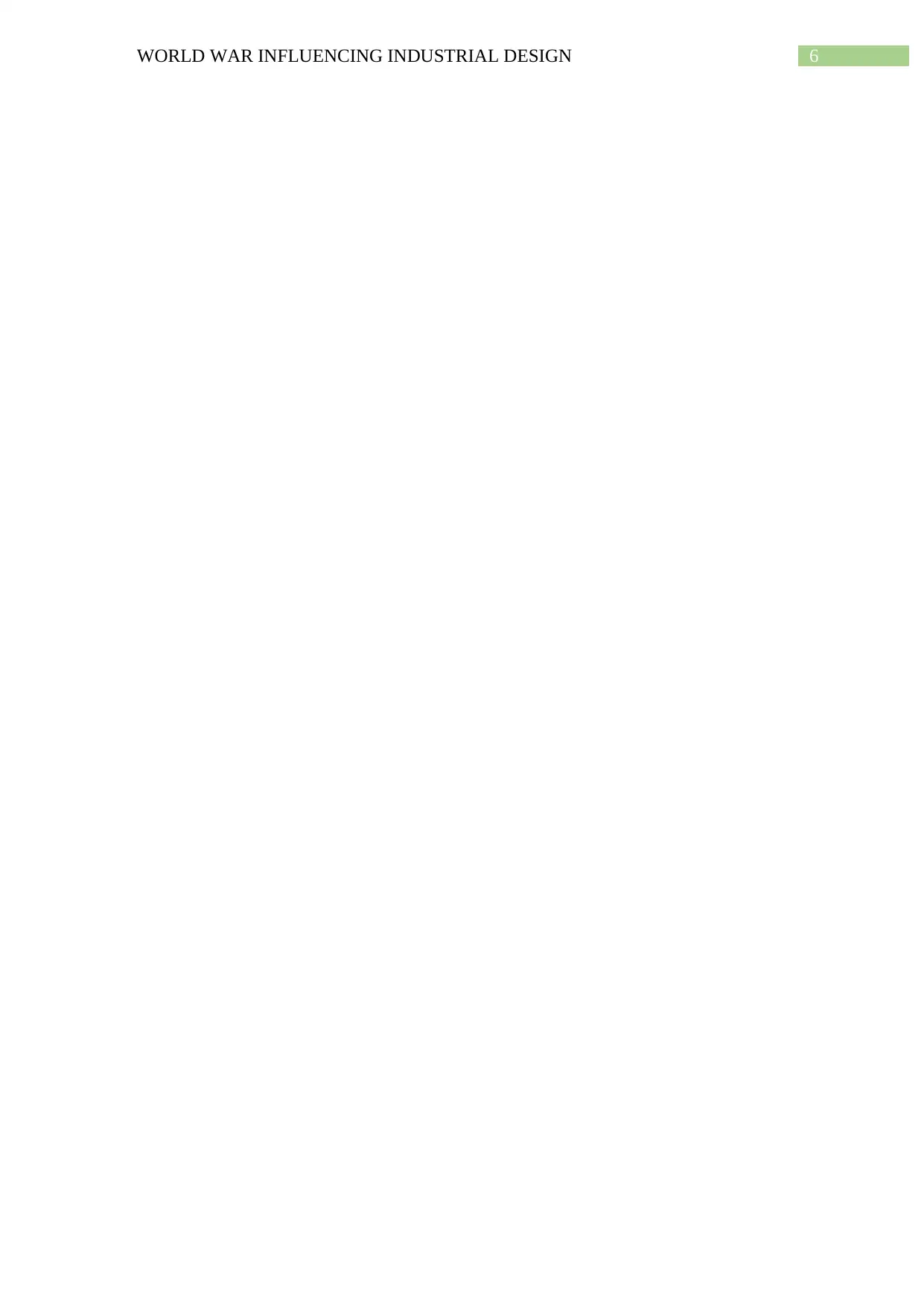
6WORLD WAR INFLUENCING INDUSTRIAL DESIGN
1 out of 7
Your All-in-One AI-Powered Toolkit for Academic Success.
+13062052269
info@desklib.com
Available 24*7 on WhatsApp / Email
![[object Object]](/_next/static/media/star-bottom.7253800d.svg)
Unlock your academic potential
© 2024 | Zucol Services PVT LTD | All rights reserved.